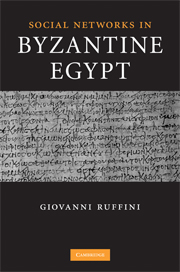Book contents
- Frontmatter
- Contents
- Dedication
- List of figures
- List of tables
- Acknowledgements
- References and abbreviations
- Introduction
- Chapter 1 The centralized elite of Oxyrhynchos
- Chapter 2 The growth of the Apions
- Chapter 3 Aphrodito and the strong ties of village society
- Chapter 4 Quantifying Aphrodito's social network
- Conclusion
- Stemmata
- Bibliography
- Subject index
- Index locorum
- References
Bibliography
Published online by Cambridge University Press: 26 June 2009
- Frontmatter
- Contents
- Dedication
- List of figures
- List of tables
- Acknowledgements
- References and abbreviations
- Introduction
- Chapter 1 The centralized elite of Oxyrhynchos
- Chapter 2 The growth of the Apions
- Chapter 3 Aphrodito and the strong ties of village society
- Chapter 4 Quantifying Aphrodito's social network
- Conclusion
- Stemmata
- Bibliography
- Subject index
- Index locorum
- References
- Type
- Chapter
- Information
- Social Networks in Byzantine Egypt , pp. 257 - 272Publisher: Cambridge University PressPrint publication year: 2008



